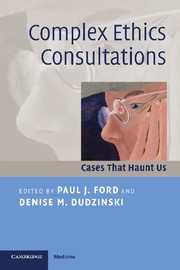Book contents
- Frontmatter
- Contents
- List of contributors
- Foreword
- Acknowledgments
- Introduction: Live and learn: courage, honesty, and vulnerability
- Part I Starting at the beginning: prenatal and neonatal issues
- Part II The most vulnerable of us: pediatrics
- 5 She was the life of the party
- 6 The sound of chains
- 7 Susie's voice
- 8 Access to an infant's family: lingering effects of not talking with parents
- Part III Diversity of desires and limits of liberty: psychiatric and psychological issues
- Part IV Withholding therapy with a twist
- Part V The unspeakable/unassailable: religious and cultural beliefs
- Part VI Human guinea pigs and miracles: clinical innovations and unorthodox treatment
- Part VII The big picture: organizational issues
- Conclusions, educational activities, and references
- Index
5 - She was the life of the party
Published online by Cambridge University Press: 03 May 2010
- Frontmatter
- Contents
- List of contributors
- Foreword
- Acknowledgments
- Introduction: Live and learn: courage, honesty, and vulnerability
- Part I Starting at the beginning: prenatal and neonatal issues
- Part II The most vulnerable of us: pediatrics
- 5 She was the life of the party
- 6 The sound of chains
- 7 Susie's voice
- 8 Access to an infant's family: lingering effects of not talking with parents
- Part III Diversity of desires and limits of liberty: psychiatric and psychological issues
- Part IV Withholding therapy with a twist
- Part V The unspeakable/unassailable: religious and cultural beliefs
- Part VI Human guinea pigs and miracles: clinical innovations and unorthodox treatment
- Part VII The big picture: organizational issues
- Conclusions, educational activities, and references
- Index
Summary
Case narrative
“She has always been the life of the party,” her mother responded when asked to describe her 7-year-old daughter. “She has always been at the center of everything in our household … she is so full of joy.” Despite that description, Rachel's parents were asking the pediatric intensive care unit (PICU) team to withdraw the ventilator and vasopressors keeping Rachel alive.
I first met Rachel when she arrived at our hospital three days earlier in septic shock. I was the emergency department (ED) physician on duty when Rachel arrived by ambulance. Her blood pressure was lower than it should have been. She was cool and pale, her arms and legs mildly cyanotic, her frightened face partially hidden behind an oxygen mask. I gently lifted the mask and told her she would be OK and that we were going to take care of her. We quickly started IVs and antibiotics. Shortly after her arrival, one of our nurses noticed that Rachel had developed spots on her feet. On closer examination, they appeared to be petechiae (pinpoint-sized spots that represent bleeding into the skin), a sign that Rachel's illness might be the result of a microorganism named meningococcus. Meningococcus infections can progress rapidly and lead to death or serious complications. Rachel's blood pressure improved with our efforts, and I transferred her to the PICU. She still looked terrified as she was wheeled out of the emergency department. I took her hand, looked into her face, and told her once again that we would take good care of her.
- Type
- Chapter
- Information
- Complex Ethics ConsultationsCases that Haunt Us, pp. 45 - 51Publisher: Cambridge University PressPrint publication year: 2008



